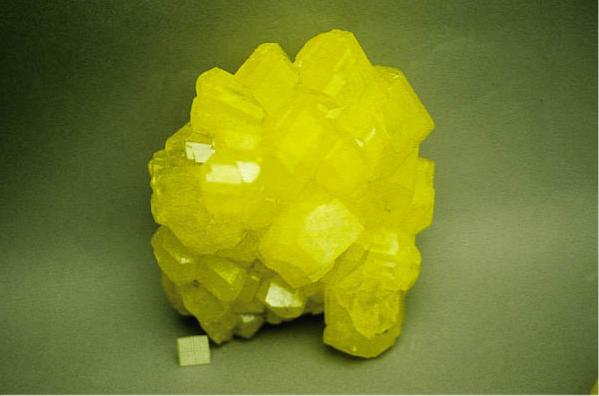
Merry Blogmas for December 4: Sulfur
We continue today with our daily “Merry Blogmas” posts on fun bite-sized science topics, which will run until Christmas.
SULFUR
Sulfur is one of the coolest elements going. It’s also on the smelliest things on the planet. It stinks enough that I included it in the article I wrote for listverse.com on 10 rocks that stink.
Sulfur has some really cool properties.
- It’s a soft yellow mineral that can be set on fire.
- It burns with a blue flame.
- While it burns, some of it melts from the heat and oozes away as a blood-red liquid.
- If you hold a solid clump of sulfur in your hand and let it warm up from your touch:
- it will start to stink
- it will make crackling sounds, kinda like puffed-rice cereal
Cast That Sulfur Away!
You can cast molten sulfur in molds!
- Sulfur can be melted at ~240 °F (115 °C), which you can reach on any stove.
- Because of the nasty fumes produced and the fire hazard, I personally would do this outdoors on a portable heat plate.
- A sulfur fire can be put out by depriving it of oxygen with a CO2 fire extinguisher or by dumping a non-combustible non-reactive substance like powdered bentonite on it.
- Don’t use liquid water to put out a sulfur fire: it might explode.
- You can cast sulfur into any pot-metal jello mold or any plaster or stone mold. Some silicon molds can also be used – check their heat ratings first.
- Just after casting, the sulfur will have a deep yellow color and it will feel springy like natural rubber or latex.
- After a few hours, the amorphous, springy sulfur will transform into a micro-crystalline form, harden up and turn pale yellow.
Where Sulfur Comes From
Sulfur comes from four different sources:
- It forms deposits at volcanoes.
- Volcanic sulfur has been mined in places with active volcanoes like Sicily and Japan.
- It forms deposits at hot springs.
- Hot spring sulfur used to be mined in Northern California, at Sulphur Bank on the shore of Clear Lake.
- It forms on top of salt domes.
- The sulfur is accumulated by anaerobic bacteria who suck it out of sulfur-bearing salt-dome minerals like gypsum.
- It is usually mined hydraulically by pumping with hot water.
- Mining sulfur from salt domes was once common in Texas and Louisiana.
- It comes out of oil wells.
- A lot of sulfur is currently stripped from crude oil coming out of wells and sold commercially.
Sulfuric Acid
Sulfuric acid used to made from from mineral sources like pyrite or the common sulfate minerals.
Because of the abundance of oil wells and salt domes, elemental sulfur is now cheaper and much more abundant as a commodity than it used to be before the 20th century. Because of the lower cost and greater supply, sulfuric acid is now made from elemental sulfur.
When I was living in Texas, I used to count 120 tanker cars of sulfuric acid per train rolling north through the rail road crossing in my town, coming out of the oil refineries and chemical plants of the Texas Gulf Coast.
